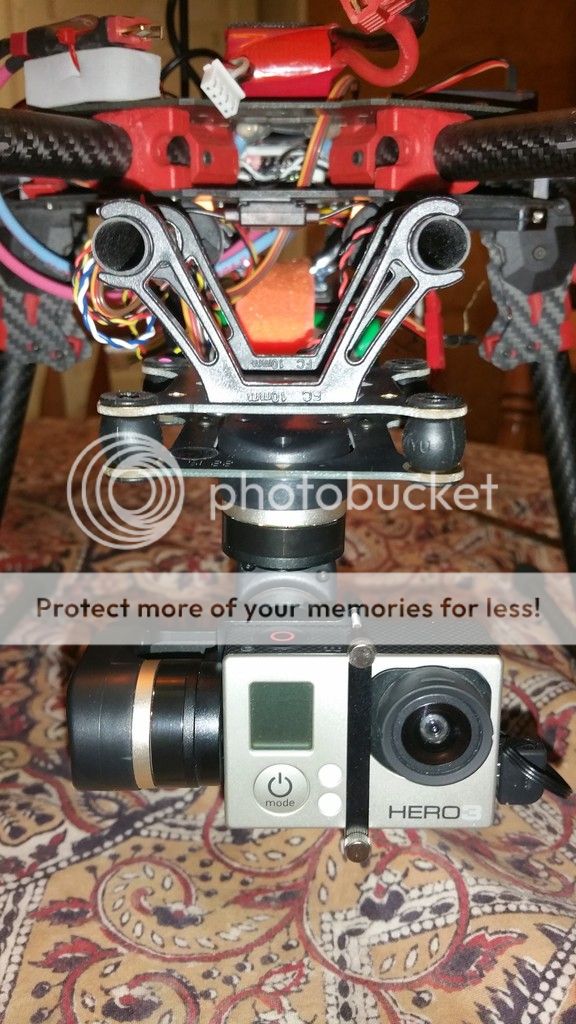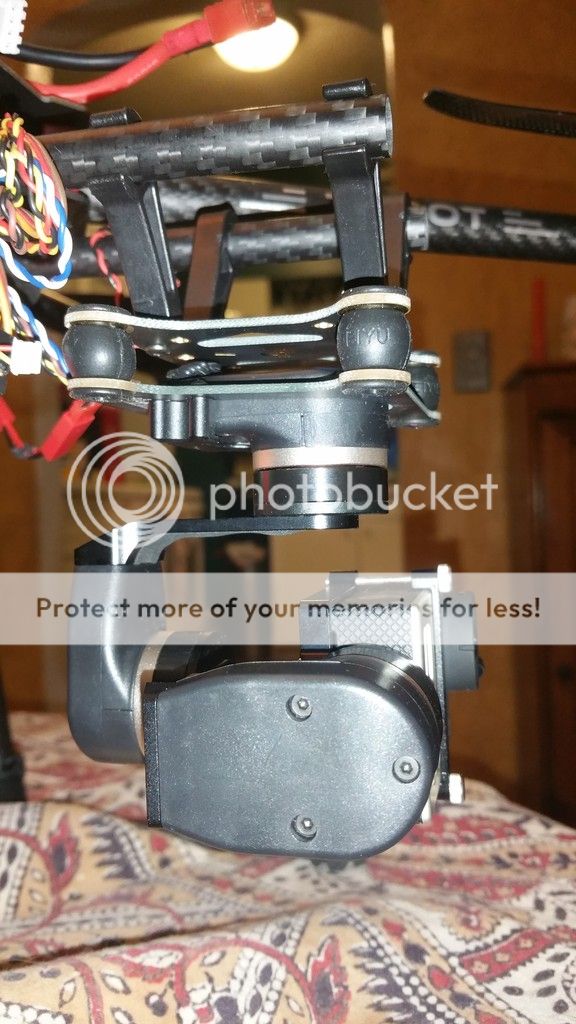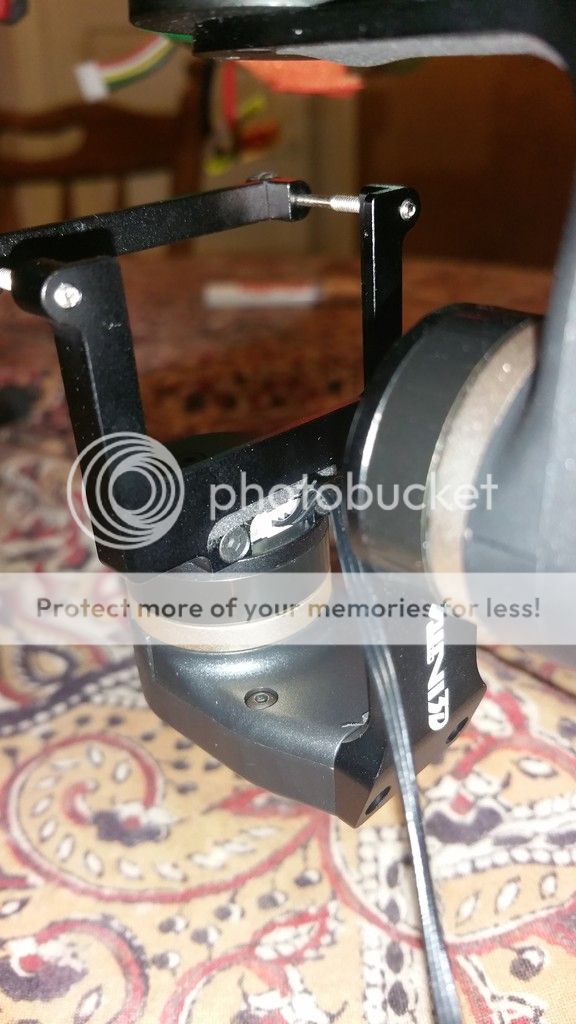Stradawhovious
"That guy"
Not long ago, I decided to cut corners and buy a $40 Gimbal for my AP Hex. That tuenrd out to be unfruitful. Not that the Gimbal didn't work... it did... It just didn't work well.
At the LHS the other day I was talking to one of the permanent fixtures there about this issue. He recommended I look at the Feiyu Tech Mini-3D 3 axis Gimbal (henceforth referred to as the FY3D. He advised that he owned two of them, and liked them more than his Zenmuse gimbals. That wouldn't be too surprising, if the FY3D wasn't less than $175. $174.95 to be exact at this particular LHS. With the promise that I could return it if it wasn't EXACTLY what I was looking for, I didn't see what I had to lose. Well, other than $187.72 after tax.



First impressions... MUCH higher quality than my $40 GoodLuckBuy cheapie. The instruction manual is lacking, but adequate for assembly and understanding where the leads go and the min/max voltage requirements. Nothing on switching settings with the tx though... that takes a little guesswork. The fit and finish is very nice, except the rail mount standoffs. The top plate holes were slightly wider than the screw inserts on the standoffs. With a little fanagling it went together OK.
Next, the power lead is incorrect. It comes with a JST connector, but the male end, not the female end so I needed to fabricate an adapter to connect it to a power supply. No big deal.
After installation and mounting the GoPro, I found that it comes with a short lead that plugs into the Mini USB port on the camera, and apparently SOMEWHERE on the gimbal. Try as I might, I couldn't see where it was supposed to plug in, and there was no mention in the manual. A little google-fu showed that the input was cleverly hidden beneath a tiny strip of foam that I would have never found. Not ever. (see picture below for location) Good thing someone had though, because it creates a bypass for your video output and power input for the camera. Well, kind of the power input. The lead has a 4 prong output plug, but only 3 wires. If you want to power the camera in flight, you need to purchase another lead with 4 wires. No big deal. It's nice that the wires will never be in the way or hinder the movement of the gimbal though.

When powering it up for the first time, the camera did a little dance and it leveled out. Well, kind of leveled out... it was about 2 degrees off level (which you will see in the quick demo video later) and that needs to be resolved in the software you download from the FY website.
Before toying with any of that, I decided to try a test video. It went great, but the camera really bobbled around a lot. This was due to the REALLY soft vibration dampening balls that were included. I bet they work great in the winter, but for anything north of 30 degrees, they are just too soft. I almost completely resolved that by inserting soft foam earplugs into the ball. Yes, I crammed an earplug inside each of the four dampening balls right through the tiny little hole in the top. Firmed them up quite a bit and really helped with the bobbling.
After installing the USB driver and setting software, I still can't get the two to communicate. The computer recognizes that the gimbal is plugged it, the software recognizes the port that the gimbal is utilizing, but they won't talk to one another. I will figure that out soon enough... probably withe the help of my more computer savvy friends.
After installing the pitch control lead to my rx and setting the mins and maxes in my transmitter I took it out for another flight. By this time it was about 7:30 and darkish, so the video quality is less than awesome. At least I THINK that's the reason the image quality is crap. It's a new (used) camera (GoPro Hero3 Silver), so who knows.
The system seems to be unaffected by vibration, and the gimbal performs very well on all three axis. I'm really looking forward to trying this out in a brighter environment, where I have a subject to follow.
I will update as I get more experience with this piece of hardware, but for now the outlook looks pretty good. Let me know if you have any questions, concerns or inappropriate jokes.
At the LHS the other day I was talking to one of the permanent fixtures there about this issue. He recommended I look at the Feiyu Tech Mini-3D 3 axis Gimbal (henceforth referred to as the FY3D. He advised that he owned two of them, and liked them more than his Zenmuse gimbals. That wouldn't be too surprising, if the FY3D wasn't less than $175. $174.95 to be exact at this particular LHS. With the promise that I could return it if it wasn't EXACTLY what I was looking for, I didn't see what I had to lose. Well, other than $187.72 after tax.



First impressions... MUCH higher quality than my $40 GoodLuckBuy cheapie. The instruction manual is lacking, but adequate for assembly and understanding where the leads go and the min/max voltage requirements. Nothing on switching settings with the tx though... that takes a little guesswork. The fit and finish is very nice, except the rail mount standoffs. The top plate holes were slightly wider than the screw inserts on the standoffs. With a little fanagling it went together OK.
Next, the power lead is incorrect. It comes with a JST connector, but the male end, not the female end so I needed to fabricate an adapter to connect it to a power supply. No big deal.
After installation and mounting the GoPro, I found that it comes with a short lead that plugs into the Mini USB port on the camera, and apparently SOMEWHERE on the gimbal. Try as I might, I couldn't see where it was supposed to plug in, and there was no mention in the manual. A little google-fu showed that the input was cleverly hidden beneath a tiny strip of foam that I would have never found. Not ever. (see picture below for location) Good thing someone had though, because it creates a bypass for your video output and power input for the camera. Well, kind of the power input. The lead has a 4 prong output plug, but only 3 wires. If you want to power the camera in flight, you need to purchase another lead with 4 wires. No big deal. It's nice that the wires will never be in the way or hinder the movement of the gimbal though.

When powering it up for the first time, the camera did a little dance and it leveled out. Well, kind of leveled out... it was about 2 degrees off level (which you will see in the quick demo video later) and that needs to be resolved in the software you download from the FY website.
Before toying with any of that, I decided to try a test video. It went great, but the camera really bobbled around a lot. This was due to the REALLY soft vibration dampening balls that were included. I bet they work great in the winter, but for anything north of 30 degrees, they are just too soft. I almost completely resolved that by inserting soft foam earplugs into the ball. Yes, I crammed an earplug inside each of the four dampening balls right through the tiny little hole in the top. Firmed them up quite a bit and really helped with the bobbling.
After installing the USB driver and setting software, I still can't get the two to communicate. The computer recognizes that the gimbal is plugged it, the software recognizes the port that the gimbal is utilizing, but they won't talk to one another. I will figure that out soon enough... probably withe the help of my more computer savvy friends.
After installing the pitch control lead to my rx and setting the mins and maxes in my transmitter I took it out for another flight. By this time it was about 7:30 and darkish, so the video quality is less than awesome. At least I THINK that's the reason the image quality is crap. It's a new (used) camera (GoPro Hero3 Silver), so who knows.
The system seems to be unaffected by vibration, and the gimbal performs very well on all three axis. I'm really looking forward to trying this out in a brighter environment, where I have a subject to follow.
I will update as I get more experience with this piece of hardware, but for now the outlook looks pretty good. Let me know if you have any questions, concerns or inappropriate jokes.
Last edited:
